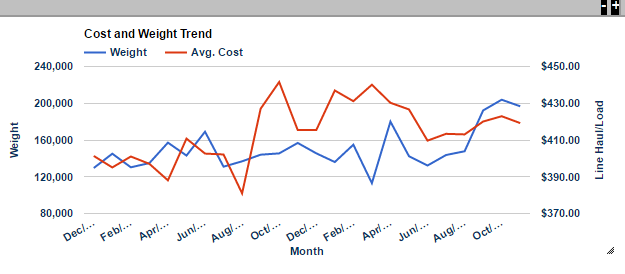Selecting Great Metrics
Home | About Map Metrics | Metric 4 Pillars | Using XMR Charts

The way to determine if you are getting better worse or
standing still with your transportation execution is to set good metrics.
Metrics should be tracked by lane but also by carrier and employee.
Employees that could be tracked with the transportation metrics include Load
Planners, Dispatchers, Salespeople and Logistic Managers.
Metrics should not only be measurable but should also
be tracked against a benchmark. It is important that you are able to set
your benchmark at the lane level as well as at the overall company level. In
this way you can have different costing benchmarks for different end
customer requirements or different weight benchmarks for your weight per
truck benchmark based on origin and destination permit requirements. In this
way the logistics group is not penalized when conditions are dictated to
them that increase costs.
In general there are there are two types of metrics;
Costing and Execution. Each type of metric is normally influenced in some
way by a company’s logistics group
and by the external service provider
Cost Metrics
With all the cost metrics it is important to set rules
for how to deal with the inconsistent items that may cause wild
fluctuations. The latter would include stops when the majority of loads are
1 stop and occasional detention charges
Overall Cost:
The overall cost metric may use line haul or total freight cost. Cost
tracking is normalize to cost per mile for long haul routes or total cost
for short haul Within a specific lane the changes in the overall cost metric
is a good general guide to what is happening with your costs.
Unit Of Measure
(UOM) Cost: The unit of measure cost metric tracks cost using a specific
unit of measure relevant to your company. For example, CWT for Aluminum
companies, LB for Steel companies, TEU for steam ship companies etc. The UOM
Cost metric for a load is the cost divided by the UOM thus if the UOM is LB
the metric is the cost divided by the weight in LB’s.
Percent Of
Revenue This metric is the percent of sales revenue taken by the cost of
transportation. The cost is normally total fright cost and may also include
a overhead amount for the cost of the logistics group. The metric is
calculated by taking cost and dividing it by revenue generated by the
delivery of the load. This is a good metric to track sales people.
Execution Metrics
On Time Pickup
– On time pickup can be looked at in two different ways
Requested
Pickup – How did the service provider perform against the requested
pickup date or pickup date and time.
Scheduled
Pickup – How did the service provider perform against the scheduled
pickup date or pickup date and time.
On Time
Delivery– On time pickup can be looked at in three different ways
Customer
Requested Delivery – How did you perform against the customer promised
or requested delivery date or delivery date and time. This metric measures
the performance of your company and your service provider. In many cases the
customer promised or requested date cannot be met by a carrier because it is
in the past.
Requested
Delivery – How did the service provider perform against the requested
delivery date or delivery date and time.
Scheduled
Pickup – How did the service provider perform against the scheduled
delivery date or delivery date and time.
In the case of
the on time metrics different benchmarks may be applied to each, for
example it should be expected the service provider will be close to 100% of
the scheduled pickup or scheduled delivery time as this was a date and time
set by the service provider.
Capacity
Utilization – This metric can be applied in a number of different ways
depending on your company This metric is an important driver for the UOM
cost metric and is a good metric to measure the performance of load
planners.
UOM per Load
- This metric works for most
unit of measures for example LB, CWT, Ton, Pallet, Cube etc. Benchmarks for
the metric should be set by lane particularly for weight type unit of
measures.
Percent
Utilization – This metric is a good measure when the unit of measure is
cube or TEU.
Freight Claim
Percentage – This metric measures the cost of freight claims as a
percentage of the total freight cost. This metric will quickly identify poor
performing service providers as it relates to the handling of your goods.
561.571.BLUE(2583)
© Sky Blue Logistics 2015